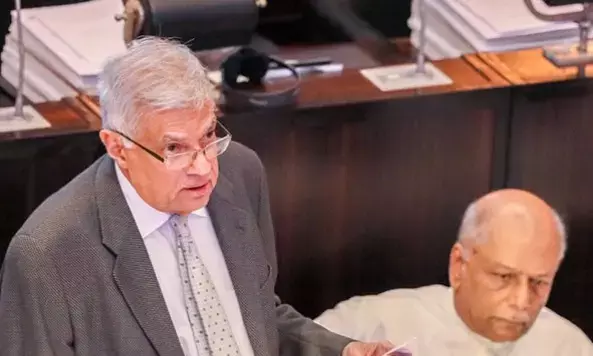'Sri Lanka is Talking to IMF as a Bankrupt Country' - Wickremesinghe
Debt restructuring scheme in August

The Sri Lankan Prime Minister Ranil Wickremesinghe told Parliament on Tuesday that this time Sri Lanka is talking to the IMF not just as a developing country, but as a "bankrupt" country. This means that getting IMF's help will be a complicated process, he warned.
The government, he explained, will have to submit a debt restructuring program to the IMF, which it will do in August. After that, the IMF and the government will be entering into a Staff- Level Agreement. Once a Staff-Level Agreement is reached, it will be submitted to the IMF Board of Directors for approval.
Sri Lanka's debt restructuring scheme is being prepared by international financial and legal experts, Lazard and Clifford Chance.
Though the road ahead is hard and challenging, given the bankruptcy and the huge debt burden, there appears to be light at the end of the tunnel. At the end of 10-days of talks with Sri Lanka, the IMF team had said that "positive and productive discussions were held on supportive economic policies and reforms. Significant progress was achieved."
In a grim portrayal of the Lankan economy, the Prime Minister said: "Our economy is currently shrinking. We are trying to reverse it. According to central bank statistics, our current economic growth rate is between negative four and negative five. According to IMF statistics, it is between negative six and negative seven. If we make a determined journey along a road map, we can achieve an economic growth rate of negative one by the end of 2023."
"By 2025, our aim is to create a surplus in the primary budget. Our effort is to raise the economic growth rate to a stable level. Our expectation is to establish a stable economic base by 2026."
Giving an idea of Sri Lanka's debt burden, Prime Minister Wickremesinghe said: "US$ 3.4 billion of debt repayment is due between June and December this year; US$ 5.8 billion in 2023; US$ 4.9 billion in 2024; US$ 6.2 billion in 2025; US$ 4.0 billion in 2026; and US$ 4.3 billion in 2027."
Pointing to the soaring inflation, the Prime Minister said that by the end of 2022, inflation will hit 60%, due to the increase in the prices of goods in the world market and the fall in the value of the rupee. The depreciation of the rupee has reduced the value of the money in the Employees' Provident Fund and the Employees' Trust Fund by 50%. The real value of pensions has decreased by 50%. People's purchasing power has decreased by about 50%. Poverty is increasing due to this.
Therefore, the rupee has to be strengthened and not let it fall, the PM said and added: "For that purpose, we have implemented a plan to limit the printing of money in the future. In 2023, we will have to print money with restrictions on several occasions. But by the end of 2024, it is our intention to stop printing money completely. We aim to reduce the inflation rate to between 4 and 6 percent by 2025."
Protecting the banking and financial system is the urgent need. The government will pay special attention to state banks sucked dry by the loss making State owned enterprises, the PM said.
"As of March 31, 2021, Sri Lankan Airlines owed Rs. 541 billion; as of May 31, 2022, the Electricity Board owed Rs. 418 billion; the Petroleum Corporation owed Rs. 1.46 trillion. When public enterprises continue to incur losses, the entire citizenry suffers. We will have to restructure Electricity Board, Ceylon Petroleum Corporation and Srilankan Airlines."
Throwing a challenge to the firebrand National People's Power (NPP) leader, Anura Kumara Dissanayake, the Prime Minister said that he is willing to step down and make way for Dissanayake to take over, if the latter can rescue the economy within 6 months as he claimed he could.



